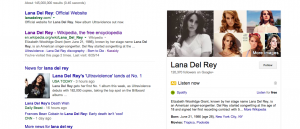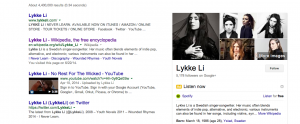Fame is random. Sometimes cream rises to the top, others a well-executed plan brings desired success. Well-deserving artists struggle to gain notoriety while some actively avoid it. Fame will be fleeting if the machine isn’t fed.
Lana Del Rey wants to be famous. Every public act she makes speaks this truth. She struggled in the shadows of NYC for several years until talent, timing, and execution created the perfect storm to propel her into the mainstream. Lana has cultivated her fame ever since by blending iconography, controversy, and improved song craft. Lana knows how to feed the machine.
I’m not ashamed to admit I like “Shades of Cool” and some of Lana’s other songs. That isn’t to say I am a fan exactly. I don’t think I’m her target audience. I crowd sourced her fans on Facebook and in their words Lana’s songs are raw, relatable, and dripping in emotion. Her voice is her power. She has the range and vibrato of an opera singer and the suaveness of a lounge act.
This is especially true on her new album Ultraviolence, which is currently most famous because Lana glamorizes her death wish and Kurt Cobain’s daughter twitterized her for it. Her new songs haven’t caught on yet, but that doesn’t matter at this juncture.
Lana’s going to be famous even if no one listens to her new songs.
But you should listen to her new songs, because a lot of them are pretty good. They might not be as catchy as the songs that made her famous, but they have more depth lyrically and musically. Dan Auerbach, lead singer of the Black Keys, produced most of Ultraviolence and he was the perfect choice. Not only did he just go through a breakup of his own, he has clearly learned a few secrets working with super producer Danger Mouse. Dan’s bluesy, nuanced production showcases Lana’s voice and has just enough shake, rattle, and roll to develop vibrancy when needed.
When I listened to Ultraviolence, it reminded me a lot of Lykke Li, especially Lykke’s new album I Never Learn. This surprised me because these similarities did not exist a couple years ago. Or at least they didn’t occur to me. Lykke is a Swedish singer with a suite of sultry indie boppers. You’ve probably heard her songs even if her name isn’t familiar.
Unlike Lana Del Rey, Lykke Li isn’t famous. Her music is well known though. “I Follow Rivers” has over 25,000,000 Spotify plays, but that doesn’t mean she’s famous. She doesn’t generate gossip or headline festivals. She’s a musician, not a celebrity.
What’s the point? For one thing, if you like Lana Del Rey you should give Lykke Li a listen. You will be glad you did. Beyond that, I think it is interesting to think of Lana and Lykke as counterparts, twins, doppelgangers. After a half-decade making music, both recently released voice-forward breakup albums bereft of the immediately catchy songs that define their earlier work. Ultraviolence and I Never Learn are stuffed with timeless ballads that would fit just as well in 1957 or 1986 as 2014. The similarities don’t end there.
Lana and Lykke were born three months apart in 1986 and started rising in 2007. They each have modeling contracts and sing lonely songs that are sometimes inhabited by anti-feminist imagery. The combination of vivid singing and spare instrumentation has made them a favorite for remixes.
Their songs are gateways to their hearts and minds. Lykke’s songs are bare meditations on love, pain, and her heart’s shortcomings. On “No Rest for the Wicked” she sings, “I let my good one down, I let my true love die, I had his heart, but I broke it every time.” Lana’s songs are filtered through a stream of affectations: drugs, Hollywood nostalgia, clothes, cars, and even religion. On “Shades of Cool” she sings, “My baby lives in shades of blue, blue eyes and jazz and attitude, he lives in California too, he drives a Chevy Malibu.”
Both blame themselves for their disintegrating love lives. It is universal to look back on a flawed relationship with a mixture of guilt and self-loathing, but Lana and Lykke choose the same metaphor to describe their pain. In “Ultraviolence” Lana says, “He used to call me poison, like I was poison ivy, I could have died right there, ‘cause he was right beside me.” On “Gunshot,” Lykke flips this to “I am longing for your poison like a cancer for its prey” and on “I Never Learn” she says, “I lie here like a starless lover, I’ll die here as your phantom lover.” Poison, death, masochism.
Ultimately, Lykke finds a sliver of hope in her troubles while Lana remains fatalistic until the last. On “Heart of Steel” Lykke begs, “Oh heart of steel, don’t kill thy song, that sings so we can heal the harm inside, don’t leave me stranded, don’t leave me alone, don’t leave me dying, without a lover to hold.” On “Shades of Cool” Lana realizes she cannot break through her boyfriend’s heart of steel, “’Cause you live in shades of cool, your heart is unbreakable.” Lana is a victim of her lover’s inability to open up while Lykke is an ice queen surveying the damage she has done.
Perhaps this difference in point of view explains why Lana and Lykke, doppelganger singers, have different reputations. Lykke’s songs are also raw and dripping with emotion, but unlike Lana’s songs, they are not relatable. Whether we admit it or not, most of us would rather be the victim than the sinner. We have been trained to process our emotions through materialism and would rather look back on the past with Lana’s fond nostalgia than Lykke’s brutal remorse. And so Lana is the glamorous superstar and Lykke the brooding indie singer, though beneath the surface their heartbreak is virtually identical.
Tags : breakup albums, breakups, Girlzone, Hollywood, I Never Learn, Lana Del Rey, Lykke Li, music, Music Musings, Ultraviolence


Subscribe. Follow. Like.
To RSS Feed
Followers
Fans